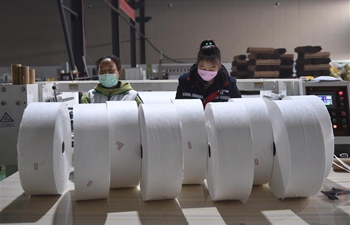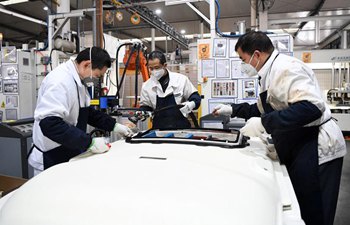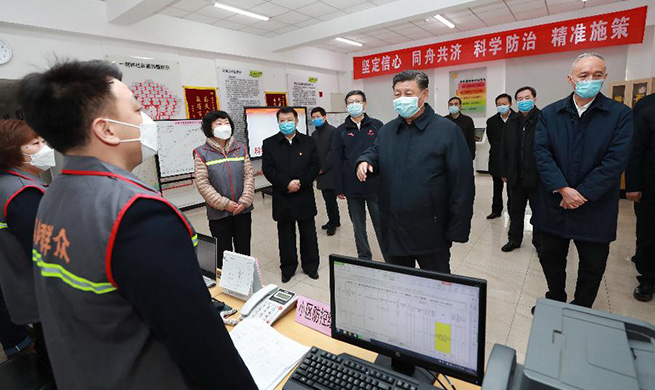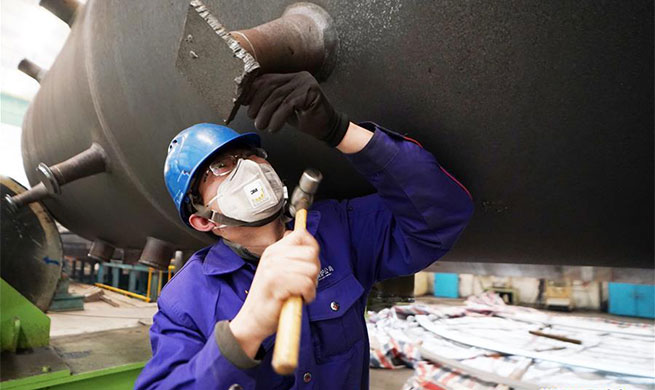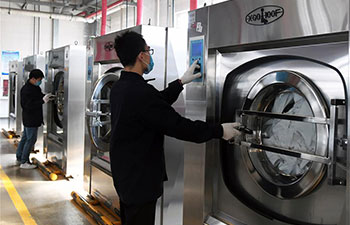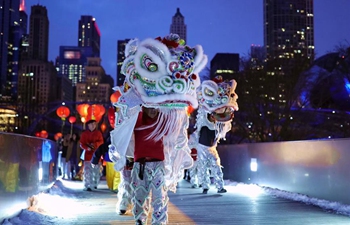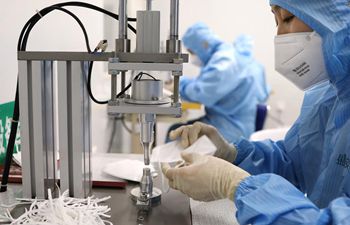by Julia Pierrepont III
LOS ANGELES, Feb. 13 (Xinhua) -- Another big Oscar winner this year behind the scenes was audio and video technology pioneer, Dolby Laboratories. They celebrated a juggernaut sweep of the winners and nominees in the audio and visual categories at the 92nd Academy Awards.
Dolby technologies played their part in the Oscar wins of "Parasite" (Best Picture, Best Director, Best International Feature Film and Best Original Screenplay), "1917" (Best Sound Mixing, Best Cinematography and Best Visual Effects), "Ford v Ferrari" (Best Film Editing and Best Sound Editing) and "Toy Story 4" (Best Animated Feature Film) and others.
All 10 Oscar nominees for Sound Editing ("Ford v Ferrari," "1917," "Joker," "Once Upon a Time in Hollywood," and "Star Wars: The Rise of Skywalker") and Sound Mixing ("Ford v Ferrari," "1917," "Joker," "Once Upon a Time in Hollywood," and "Ad Astra") used Dolby Atmos to achieve their finest creations. Four of the five Cinematography nominees opted for an assist from Dolby Vision.
A reception for the 2020 Oscar nominees in Sound Editing, Sound Mixing, and Cinematography was hosted by Dolby Laboratories at the Academy of Television Arts and Sciences in North Hollywood just prior to the Oscars to celebrate the talented craftsmen and women who use their tools to push the artistic and technical envelopes of their crafts.
Since the release of Star Wars in the 1970s, movies with Dolby sound technology have won 68 Oscars in the categories of Sound Mixing, Sound Editing, and Sound Effects Editing.
Ben Burtt, a multiple Oscar-winning sound engineer, described Ray Dolby, founder of Dolby Laboratories, as "a scientist who invents tools for artists," enabling them to seamlessly blend the science and creative cornerstones of entertainment.
Dolby Atmos, used by all the Oscar nominees, features 128 audio tracks including associated spatial info. It is described as a surround sound technology enhancing and elevating the traditional 2D surround system by introducing height that enables sound to be interpreted in 3D space with objects that can be moved smoothly from speaker to speaker around the movie theater when the film is screened to create a more immersive experience for moviegoers.
Ioan Allen, Dolby Labs' senior vice president, told Xinhua, "Ultimately, our job is simple: to make it sound better and look better."
Alan Robert Murray, sound editing Oscar nominee for "Joker," told Xinhua, "(The director) Todd (Phillips) wanted us to always be with Arthur Fleck (Joker) in his world. So we used Dolby Atmos to build a complete sound field all around (the audience) to make you feel like you were right there with Arthur."
Tom Ozanich, Oscar-nominated sound mixer for "Joker" explained to Xinhua, "One of the cool things about Atmos and the most misunderstood is that they think it's just about those big action scenes with helicopters flying overhead and bombs going off."
He demurred, "But it can be used in simple scenes too ... as we pan around and (the Joker) walks by the TV ...The detail you can get of the movement of those kinds of things you just can't get anywhere else. And that adds to the feeling of reality -- like you're really there."
Donald Sylvester, this year's Oscar-winner for Best Sound Editing for "Ford v Ferrari," told Xinhua he felt his biggest challenges were to track down and use the authentic engine sounds of the actual racecars used in the movie, and to not blow people out of the theaters with their volume on screen during the race scenes.
"Our sound mixers balanced it perfectly," he said. "And they should be up here too (getting an Oscar)."
His most exciting moment of the film, audio-wise, was when composers, Marco Beltrami and Buck Sanders, set the film's score in the same musical key as the engine.
"There are points in movie where the music hits like sound effects -- you can hear a chord of music and sound effects together -- that was amazing," he said.
Sylvester has worked several times in China and told Xinhua how much he admires the Chinese and looks forward to the opportunity to continue to teach them the techniques it took him decades to learn.
"They welcome you with open arms and want what you have to offer, but sometimes they think one masterclass or six months of training is enough to learn everything they need to know," he chuckled.
Other Oscar winners for Best Sound Mixing, Stuart Wilson and Mark Taylor said of the biggest challenge they confronted on World War I epic "1917" not having any obvious joins -- sonically, as well as visually.
"You don't get a single change. No cuts," Wilson said. "A continuous shot means it's essential to maintain connection with the lead characters so you stayed with them on the journey."
On the visual front, other than "The Lighthouse," which was shot non-digitally using black and white film stock, all the nominees for Best Cinematography used Dolby Vision.
Dolby Vision is content mastering and delivery format that supports both high dynamic range (HDR) imaging and wide color gamut (ITU-R Rec. 2020 and 2100) all throughout the production, post-production and transmission process.
Mark Ulano, who was nominated for a whopping two Oscars this year for "Once Upon a Time In Hollywood" and sci-fi pic, "Ad Astra," told Xinhua, "These kinds of tools are our hammers and nails to achieve specific outcomes. Every shot is handmade and constructed by passionate artists and craftspeople to transcend the physical and tell the story."


